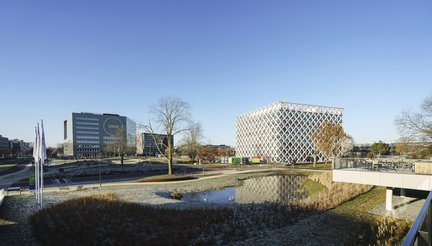
With the Future-proof value concept, Heijmans is putting itself on the map as the sustainable housing partner for utilities buildings. The basic premise: ensuring that every building creates more value for its users, now and in the future. Eelke Stellingwerf, director of the Services unit in Apeldoorn, reveals his strategy.
1. 1 What is Future-proof value?
“It’s an initiative of our colleagues at the Utility Services business unit. A new phrase, which actually covers everything: the future, real estate, adding value. The main question is: how do you keep real estate value stable, for the building, the environment and users? We have two goals: increasing user value and property value. We take a long-term view, thinking along as a partner at strategic level and guiding our clients. Thanks to continuous improvements, buildings retain their value well into the future. This goes beyond sustainability, as safety, health and user experience also play a role. Right now, getting rid of gas is very much in demand, but clients may also want to improve the safety level of their buildings. That’s when our main task is to keep the building safe through smart installations, or by digitalising processes. That too falls under Future-proof value.”

2. How did this concept come about?
“We were one of the biggest players in the market, but we were not really known for our sustainable management and maintenance. Then we asked ourselves the question: how can we make sure that Heijmans is known as the most sustainable housing partner? Various parts of the organisation were all selling different sustainability propositions separately. That led to a fair bit of confusion among our clients. Data and craftsmanship already played a big role within Services. Data helps us to make buildings smarter. Professionalism is about our people, who really know how to tackle buildings. But how exactly do those things contribute to making a building more sustainable? That’s what we wanted to tell the world.
With Future-proof value, we’ve bundled everything: smart solutions, technology and sustainability. We started with a sustainability proposition, but now we offer much more. By combining our knowledge, we become that sustainable housing partner. A good example of this is the Sustainable Housing Roadmap, which we use to work with our clients to shape the sustainable transition of their assets.”

3. That sounds great. What does it look like in practice?
“This is where we deploy our technology, such as smart installations, or by controlling and monitoring things remotely, by digitalising buildings and developing platforms that generate data, which we can then use to come up with yet more new solutions. We work with our clients to look at what is possible. Sometimes these are big, but you can also achieve sustainability through small and practical things. With some clients, we are responsible for maintenance and energy consumption.
That’s when the professional skills of our people really come into play. They know exactly how to fine-tune a building so that no unnecessary energy is consumed. Like a building that is kept warm until eight in the evening, while everyone goes home at five. Simply taking away those extra hours gives your first benefits. When it comes to sustainability, there is often so much more you can do than you might think. For other clients, we put our heads together on a long-term basis by analysing the long-term housing plan with the client. For instance, a so-called ‘Paris-proof scan’ can quickly provide insight into which buildings can generate the most benefits if you’re looking to reduce your CO2 emissions.”
4. Are you conscious of sustainability yourself?
“I live in the middle of the Utrechtse Heuvelrug (a national park at the heart of the Randstad urban conurbation) and enjoy the nature surrounding me every single day. Eighteen months ago, the town of Leersum was hit by a unique catabatic wind, a rare natural phenomenon that we will probably experience more often due to climate change. That catabatic wind completely wiped out an entire stretch of forest, right next to where I live, in just ten minutes. That did set me to thinking.
I am more conscious of energy and consumption and would also like to make my own home more sustainable. I’m making that investment on principle and certainly not out of cost considerations, because I wonder if I’ll ever recoup those costs. For me, by the way, sustainability is also about not throwing things away or using them for as long as possible. It’s become so ingrained in us that we need to keep buying new things, but why not reuse something? That’s often just as good. On the business front, I want to make people more aware; privately, I can take concrete action myself. And that’s what I do.”

5. Is that why you wanted to engage with the Future-proof value concept in your work?
“When you’re creating new buildings these days, clients want them to be sustainable or circular. But you can have the greatest impact by making existing buildings more sustainable. You can really have a major impact on the energy consumption of those buildings or their users. There’s still a lot to be done in terms of sustainability within the built environment. I love that dynamic and I like to set my sights on the future. That’s why I’ve taken on this role.
For me, sustainability is also about how we leave the planet for future generations. I have two young children and regularly ask myself: what will the world they grow up in look like? And what can I do to make that world better for them? If you are personally behind something, it motivates you to really dedicate yourself to it professionally. At least it does with me.”
Contact us






